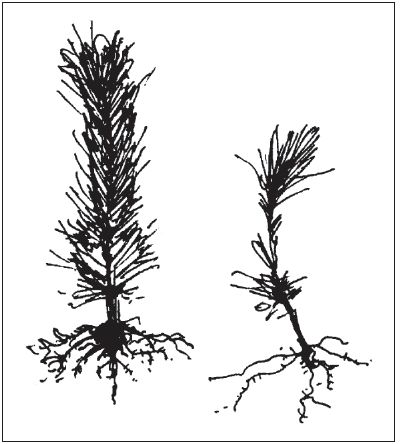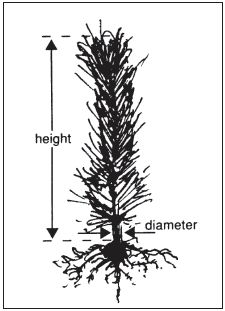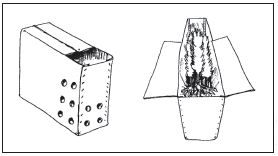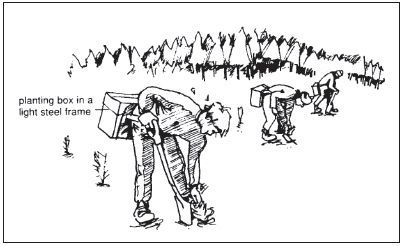Successful establishment of tree seedlings
NZFFA Information leaflet No. 3 (2005).
Introduction
Planting a tree seedling is easy – just dig a hole, place the roots in the hole and cover with soil. Successful establishment of tree seedlings so that they are still alive and growing vigorously a few years later and grow on to become mature trees, however, requires a lot more attention to detail. Good forward planning pays dividends, so always plan just what you need to do well in advance of actual planting.
Key factors for success are:
- Make sure the species chosen is suitable for the site.
- Use good quality tree stock.
- Take great care in the handling, transport and storage of seedlings.
- Ensure the planting site is well prepared, where possible by deep cultivation with a winged ripper, and perhaps pre-plant spraying with a weedicide.
- Plant seedlings as recommended in this leaflet.
- Prevent weeds from competing with the seedlings for at least a year after planting.
- Protect seedlings from browsing by stock and wild animals.

Bare-rooted stock
Bare-rooted stock are preferred to container stock for large-scale planting because:
- they are usually much cheaper to produce.
- more seedlings can be carried when planting away from roads.
- it is difficult to produce container stock large enough and sufficiently well conditioned to establish well on harder sites.
However, some species, particularly many of the eucalypts, perform much better when container grown.
Stock quality
Under ideal planting conditions, small seedlings transplant better than larger ones, with less interruption to their growth. In practice, a minimum size is required because:
- the seedling must contain sufficient food reserves not only to survive until planted, but also to make new root and shoot growth after planting. Root collar diameter is the best indicator of food reserves.
- the stem must be sufficiently hardened to withstand handling and storage without damage, resist disease and insect attack, and tolerate harsh weather conditions after planting.
- the seedling must be large enough to be planted deeply in uneven ground without being buried, and to be able to cope with any likely weed growth.
Recommended sizes for bare-rooted stock of common species
| Species | Min. root collar diameter (mm) | Desirable height (cm) |
| Radiata pine | 6 | 25-35 |
| Cypresses | 6 | 25-35 |
| Eucalypts | 6 | 40-60 |
| Douglas-fir | 10 | 40-50 |
| Blackwood | 10 | 60-80 |
To ensure that you get stock that meets these criteria, it is always best to order seedlings from your nurseryman a year in advance, and if necessary, pay a premium for quality stock. Be brutal about rejecting stock that doesn’t meet specifications. Most farmers wouldn’t hesitate to reject inferior animals when buying, but many seem prepared to accept poor seedlings from nurseries, even chasing ‘bargains’.

Besides being sufficiently sturdy, seedlings should be of uniform size, because planting a mixture of sizes will probably result in uneven growth. Insist on uniform sturdy stock for harsh sites, but be prepared to accept smaller stock (but still above the minimum size) if you have easier sites. Seedlings should have major roots which are either callused or cleanly cut, and an abundance of fibrous roots. The size of the root system will depend on the size of the top, but for large-scale plantings, the root systems should be no wider, and only half the length, of the planting spade used.
Handling and storage
Young seedlings are very vulnerable to physical damage, so treat them gently.

Lie seedlings flat for transport, because upright travel will bruise the major roots and they’ll die back after planting. Ensure that the roots are never exposed to wind or sunshine for more than a few seconds from the time they are lifted in the nursery until they are replanted in the field. If the ground is dry when seedlings are lifted, the roots should be moistened immediately and kept moist – if allowed to dry out, smaller roots quickly die.

During storage seedlings use up food reserves to respire, and respiration increases dramatically with increasing temperatures, so always keep seedlings as cool as possible, but don’t allow them to freeze. If you store seedlings temporarily at the planting site, always keep the packages out of direct sunlight, preferably in naturally shaded areas.
Planting
The future root system of the tree is largely determined by the way the roots are positioned at the time of planting. The commonest faults in planting are:
- not planting deep enough. Such trees are much more prone to topple in strong winds and to suffer moisture stress under dry conditions.
- not creating a planting hole big enough to accommodate the root system without distortion. Roots bent horizontally around the lower stem will later strangle the main stem, resulting in wind throw. If the nurseryman has not trimmed the roots sufficiently, use a sharp pair of shears and trim the roots in a cool shady place before going out to plant.
- dragging the roots into a planting slot so that they all point in the same direction, resulting in unstable trees with ‘hockey stick’ root systems.

Do not make a single spade cut and stuff the seedling in the slit you made with your spade ("slit and stuff").
Basic principles
- When planting shelterbelts on wet sites, create a raised bed by cultivating the soil in dry weather and forming a mound with an angled blade on the back of a tractor.
- Plant seedlings into cultivated or loosened soil. If the site has not been deeply cultivated by ripping or bedding, cultivate the site by hand at the time of planting so that new root growth can be made into loosened soil.
- Plant seedlings so that the root collar is buried at least 5 to 10cm; this is particularly important on dry or exposed sites, or where hand weeding is to be carried out.
- Make sure the planting hole is large and deep enough to accommodate all the roots without bending or distorting them in any way.
- Spread the roots apart as much as possible with no tangles, and cover them with loose soil. Lift the seedling 2 to 3cm while shaking, to allow soil to filter between the roots and to ensure that all roots are pointing downwards.
- Firm the surface with the sole of your boot, taking care not to strip the foliage or branches from the stem while doing so. In firming the soil, the aim should be to ensure that the surface is sufficiently compact to stop the seedling moving in the wind, but not to compact the soil too tightly round the roots, especially if it is wet and/or heavy.
- Except on wet soils or high rainfall areas, leave the seedling standing in a slight depression.
- When planting into ground which has been sprayed with a pre-emergence weedkiller, take care to prevent surface soil from falling into the planting hole.If the surface soil has been removed before digging the hole, replace it round the stem.
Time of planting
Bare-rooted seedlings should not be planted while they are actively growing, particularly once they have started to flush in the spring. Provided good hardened stock is used and the ground is moist, autumn (April) is a good time to plant, particularly in low rainfall areas. The warm soil allows the seedlings to develop new roots before winter sets in, and the winter rains ensure that soil settles evenly round the roots. However, autumn planting should not be used for frost sensitive species, if the ground is at all dry, or if good careful lifting and handling of the seedlings cannot be guaranteed.
Planting in May or early June is not recommended because seedlings then have to withstand all the vagaries of a winter climate before they can start to make new growth, and warm days can lead to winter desiccation, i.e. the leaves dry out and there are no new roots to replenish their moisture. Most planting is carried out in July or early August when seedlings are dormant and can best withstand handling. The aim should be to plant immediately before the soil warms up sufficiently for the seedlings to make new root growth. In cold climates, it is better to plant in late August rather than late June.
For sensitive species, planting is best carried out even later, after the worst of the winter frosts are past, but before the seedlings have started to grow.
For cold inland sites where planting is not possible before late September or October, seedlings should be lifted as late as possible before bud burst and held in a cool store until planting.
Container-grown stock
Although container-grown stock can be planted out at any time of the year provided the roots are not greatly disturbed, the conditions required for successful establishment of bare-rooted stock are equally applicable. In particular, do not plant containerised stock into dry soil, or soil that is liable to dry out in the near future, otherwise the potting mix the roots are growing in will rapidly dry out and kill new root growth.
Side-slot air-prune containers are the best because theyn produce less root distortions from roots deflecting off container walls. Rootrainers®, or similar containers with ribbed sides are capable of producing a "root cage" thus reducing the stability of the tree as it grows. Always cut off the bottom 2-4cm of roots before planting. Stock grown in other types of containers should be planted out before the roots are greatly affected by the sides of the containers, otherwise the seedlings will probably grow into unstable trees. In practice, this means that seedlings grown in small peat pots should be planted out when they are very small, e.g. about 10cm high.
Small stock can give excellent results provided it is carefully planted into well cultivated soil, given good weed and animal control, and is sheltered from harsh conditions until it is well established. As such stock is usually very soft, it is best planted in late spring when the danger of frosts is past. Provided the soil is moist, it can then start growing immediately and make maximum height growth before the following winter.
Much of the larger container-grown stock obtained from nurseries, however, is grown in planter bags. It is invariably root-bound to some degree, often very badly. Slicing down vertically with a knife and around the circumference of the root bundle helps, but the only sure way to ensure the future stability of the tree is to remove the container, gently shake or wash the soil out, tease out any tangled roots, and trim off any long or badly twisted ones with a sharp pair of shears.
Weed control
This is such a wide ranging subject, it is covered in a separate leaflet. Suffice to say that without a doubt, in New Zealand the greatest cause of seedling failure after planting is due to inadequate weed control. Weeds are particularly adept at extracting moisture from the soil, and have their greatest effect when conditions are dry. Vigorous weeds can also overtop and smother seedlings, greatly restricting their growing space.
For successful establishment, newly-planted seedlings require an area of one square metre (1m2) around them to be kept weed-free for the better part of one growing season, and for slower growing species, including natives, a second season free of weeds will pay dividends. Whether weed control is by grubbing, mulching, or chemical sprays is up to the individual grower, but there are many effective chemicals available these days, and spraying is the only realistic means of weed control for large-scale plantings.
Watering
The best form of watering is perfect weed control. If you have to apply water to keep newly planted seedling alive in a drought, apply about 10 litres/seedling at a time every few weeks, rather than much smaller amounts every few days. In dry conditions, root growth is attracted towards moist soil, and a heavy watering will attract root growth downward as the surface dries out. Light watering only moistens the surface, and root growth will be attracted to the surface. Do not use drip-feed watering unless you intend to continue using it throughout the life of the tree, and even then, trees will probably require staking in windy situations because they will have unbalanced root systems.
Staking
When planting large specimens of amenity trees, it is sometimes necessary to stake them to prevent them blowing over in the wind. The aim should be to keep the root system rigid until root growth can get a good grip on surrounding soil, but to leave as much of the stem free as possible so that wind movement will stimulate the stem to thicken up. When staking, use stout stakes, driven in at an angle if the tree is already planted so the root system isn’t damaged, and tie the tree to the stake at no more than a third the height of the tree, preferably lower. Use a soft broad tie (a strip of car or truck inner tube is ideal) and make sure that the stem cannot rub against the stake.
Animal protection
No matter how well you prepare the site, and choose, handle and plant your tree seedlings, all your efforts can be quickly ruined by animal damage. Fences must be absolutely stock-proof, and if you have a problem with rabbits, hares or possums, these animals must be controlled before seedlings are planted, because they can do a lot of damage in one or two nights. There are now several animal repellents available for short-term protection, but to be effective they need to be applied the day seedlings are planted, so that animals quickly learn that the seedlings are unpalatable.
You can make your own repellent by mixing 5 fresh eggs, 150 ml of acrylic white paint and 600 ml of water.
For shelterbelt plantings, placing a used car tyre over each seedling usually gives excellent protection, but make sure it is removed after a year or two. For small-scale plantings there are several forms of plastic tree guards available that give good protection from wild animals. If tree guards are used to protect against domestic stock, ensure that the guards are tall enough, and very firmly staked.
(Graphics reproduced from Establishing a Small Forest – no.5 in the Small Forest Management series, jointly produced by the Ministry of Forestry and the NZ Forest Research Institute. © Crown Copyright Ministry of Forestry, June 1996.)

 Farm Forestry New Zealand
Farm Forestry New Zealand